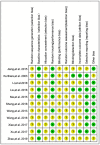Effects of Cyclocarya paliurus Aqueous and Ethanol Extracts on Glucolipid Metabolism and the Underlying Mechanisms: A Meta-Analysis and Systematic Review
- PMID: 33335910
- PMCID: PMC7736088
- DOI: 10.3389/fnut.2020.605605
Effects of Cyclocarya paliurus Aqueous and Ethanol Extracts on Glucolipid Metabolism and the Underlying Mechanisms: A Meta-Analysis and Systematic Review
Abstract
Background and Aims: Cyclocarya paliurus (CP) has been used as an herbal tea to treat diabetes mellitus and obesity for hundreds of years. Previous research suggests that CP specifically restores glucolipid metabolic homeostasis, and the two most studied preparations are aqueous and ethanol extracts. In order to verify the effect of CP on glucolipid metabolism in animal models with metabolic syndrome, a meta-analysis was performed, and the active components and underlying mechanisms were systematically reviewed. Methods: Four databases: PubMed, Web of Science, Embase, and Cochrane Library were searched to identify potential literature. Data of blood glucose (BG) level, area under curve (AUC) of oral glucose tolerance test (OGTT), total cholesterol (TC), triglyceride (TG), high-density lipoprotein (HDL), and low-density lipoprotein (LDL) levels were extracted as indicators of the assessment of CP's effects. Follow-up analyses including subgroup analysis, meta-regressions, and publication bias were also conducted. Results: A total of 96 papers were identified from the databases and 11 papers including 31 data reports were involved in the meta-analysis. CP had a positive effect in down-regulating BG, AUC of OGTT, TC, TG, and LDL, and up-regulating HDL (P < 0.001, 95% confidence interval of standard mean difference did not incorporate the null value 0). Conclusion: CP showed definite activity of regulating glucolipid metabolism in animal models, and it exerted its function through multiple mechanisms including but not limited to: (1) improving insulin resistance; (2) protecting pancreatic β cells; (3) decreasing inflammatory infiltration; and (4) anti-oxidative stress.
Keywords: Cyclocarya paliurus; dyslipidemia; glucolipid metabolism; hyperglycemia; insulin resistance; metabolic syndrome.
Copyright © 2020 Liu, Wu, Hu, Qin, Guo, Wang, Wu and Liu.
Conflict of interest statement
The authors declare that the research was conducted in the absence of any commercial or financial relationships that could be construed as a potential conflict of interest.
Figures











Similar articles
-
Antihyperglycemic, antihyperlipidemic and antioxidant effects of ethanol and aqueous extracts of Cyclocarya paliurus leaves in type 2 diabetic rats.J Ethnopharmacol. 2013 Dec 12;150(3):1119-27. doi: 10.1016/j.jep.2013.10.040. Epub 2013 Oct 30. J Ethnopharmacol. 2013. PMID: 24184190
-
Cyclocarya paliurus Leaves Tea Improves Dyslipidemia in Diabetic Mice: A Lipidomics-Based Network Pharmacology Study.Front Pharmacol. 2018 Aug 28;9:973. doi: 10.3389/fphar.2018.00973. eCollection 2018. Front Pharmacol. 2018. PMID: 30210345 Free PMC article.
-
Cholesterol-lowering effects and potential mechanisms of different polar extracts from Cyclocarya paliurus leave in hyperlipidemic mice.J Ethnopharmacol. 2015 Dec 24;176:17-26. doi: 10.1016/j.jep.2015.10.006. Epub 2015 Oct 23. J Ethnopharmacol. 2015. PMID: 26477373
-
Effects of natural dihydrochalcones in sweet tea (Lithocarpus polystachyus) on diabetes: a systematical review and meta-analysis of animal studies.Food Funct. 2022 Jun 6;13(11):5899-5913. doi: 10.1039/d2fo00245k. Food Funct. 2022. PMID: 35583219 Review.
-
Effect of fenugreek consumption on serum lipid profile: A systematic review and meta-analysis.Phytother Res. 2020 Sep;34(9):2230-2245. doi: 10.1002/ptr.6690. Epub 2020 May 8. Phytother Res. 2020. PMID: 32385866
Cited by
-
The chemical composition and toxic effects of aqueous extracts of Cyclocarya paliurus leaves.Front Nutr. 2022 Sep 29;9:994055. doi: 10.3389/fnut.2022.994055. eCollection 2022. Front Nutr. 2022. PMID: 36245541 Free PMC article.
-
Ginsenoside Rg1 attenuates the inflammation and oxidative stress induced by diabetic nephropathy through regulating the PI3K/AKT/FOXO3 pathway.Ann Transl Med. 2021 Dec;9(24):1789. doi: 10.21037/atm-21-6234. Ann Transl Med. 2021. PMID: 35071483 Free PMC article.
-
Anti-Hyperglycemic Effects of Refined Fractions from Cyclocarya paliurus Leaves on Streptozotocin-Induced Diabetic Mice.Molecules. 2021 Nov 15;26(22):6886. doi: 10.3390/molecules26226886. Molecules. 2021. PMID: 34833980 Free PMC article.
-
Potential Role of Natural Plant Medicine Cyclocarya paliurus in the Treatment of Type 2 Diabetes Mellitus.J Diabetes Res. 2021 Dec 27;2021:1655336. doi: 10.1155/2021/1655336. eCollection 2021. J Diabetes Res. 2021. PMID: 34988228 Free PMC article. Review.
-
Plant-derived triterpenoid saponins: multifaceted roles and bioengineering prospects.Plant Cell Rep. 2025 Jul 8;44(8):172. doi: 10.1007/s00299-025-03483-0. Plant Cell Rep. 2025. PMID: 40629160 Review.
References
-
- Alberti KG, Eckel RH, Grundy SM, Zimmet PZ, Cleeman JI, Donato KA, et al. . Harmonizing the metabolic syndrome: a joint interim statement of the International Diabetes Federation Task Force on Epidemiology and Prevention; National Heart, Lung, and Blood Institute; American Heart Association; World Heart Federation; International Atherosclerosis Society; and International Association for the Study of Obesity. Circulation. (2009) 120:1640–5. 10.1161/circulationaha.109.192644 - DOI - PubMed
Publication types
LinkOut - more resources
Full Text Sources
Miscellaneous

